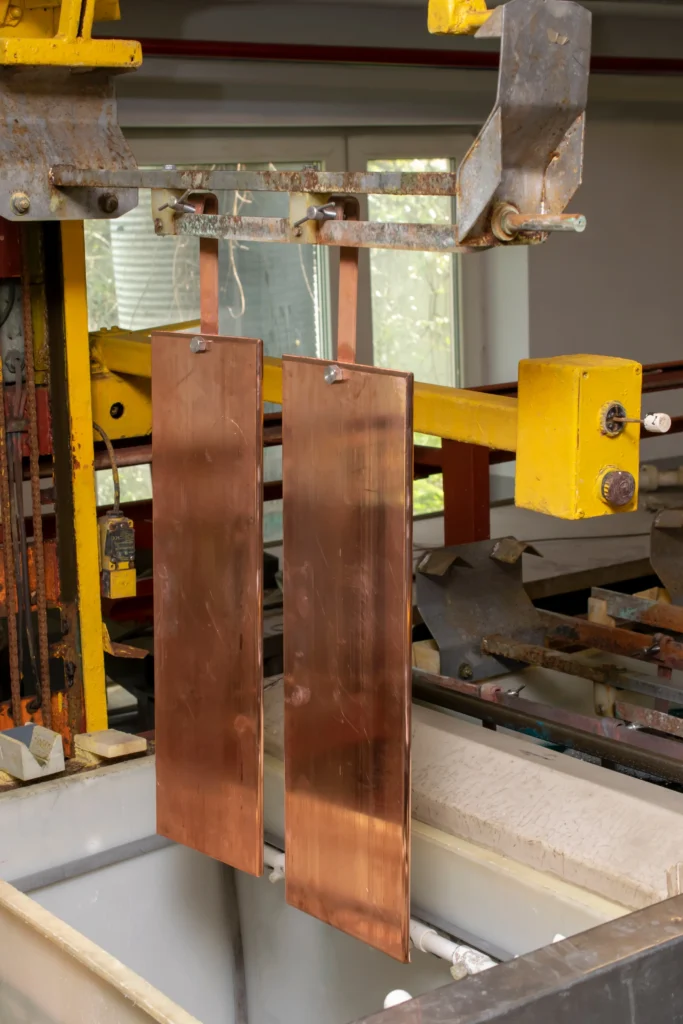In the engineering and design world, the finishing touches on metal parts are not just about aesthetics — they are crucial for enhancing performance, durability, and resistance to environmental factors. Metal plating finishes are a key component in this process, offering both protective and functional benefits.
In this guide, our expert machinists will teach you all about metal plating finishes. We’ll discuss the full treatment process, explain how this technology works, and give some examples that might help you in your next project.
What Are Metal Plating Finishes?
Metal plating finishes involve coating a substrate metal with a thin layer of another metal. In other words, adding a layer of metal to an existing piece of metal.
This process not only improves the appearance of the metal but also enhances its corrosion resistance, electrical conductivity, and wear resistance. It’s a crucial step in manufacturing that can significantly extend the life and improve the performance of metal parts.
Metal Plating Finishing 101: How it Works
To better understand how metal plating works, let’s walk through the full process:
Step 1: Pretreatment
Pretreatment is vital for ensuring the quality of the plating finish. This step involves preparing the metal surface by removing oils, dirt, and any other contaminants. Our team typically uses degreasing, sandblasting, or acid pickling to prepare your metal parts. This process ensures a clean and active surface that will adhere well to the plating material.
Step 2: The Cleaning Process
After pretreatment, the parts undergo a thorough cleaning process. Typically, this involves rinsing the parts in alkaline or acidic solutions to remove any remaining surface contaminants. Ultrasonic cleaning is also used in some cases to achieve a deep clean.
Even when a metal part looks shiny and clean, there are still microscopic contaminants on the surface that can hurt the uniformity or consistency of any plating finish we add. That’s why this step is so important.
Step 3: Setting Up the Plating Station
The plating station setup is critical. This involves preparing the plating solution, which contains the metal to be plated, and setting up the anodes and cathodes. The substrate metal to be plated is usually connected to the cathode, while the anode is the metal to be plated onto the substrate.
Step 4: The Plating Process
During the plating process, an electric current is passed through the solution, causing the metal ions from the anode to deposit onto the substrate at the cathode. In other words, the electricity forces the plating material to stick to your metal part.
The thickness of the plating layer can be controlled by adjusting the current and the time the part spends in the plating solution.
Step 5: Post-Treatment
Post-treatment often involves rinsing and drying the plated parts. In some cases, additional processes like passivation (for stainless steel) or a clear-coat finish (for aesthetic purposes) might be applied. These steps help to seal the plating and enhance its protective properties.
Step 6: Disposing of Waste
Proper disposal of waste is crucial as plating solutions can contain toxic materials. Compliance with environmental regulations is essential, and we always adhere to regulations for any plating project we perform. The waste should be treated and disposed of responsibly to minimize environmental impact.

What Are Some Common Industrial Metal Plating Finishes?
Applying a metal plating finish to a part is more common than you might realize. For industrial parts, there are a few finishes that you can see in countless industries and applications:
- Zinc plating is widely used for its excellent corrosion resistance. It’s commonly applied to steel parts to protect them from rust.
- Chrome plating is known for its hard surface and gorgeous, reflective finish. It’s used in automotive parts, household fixtures, and tools for both protective and decorative purposes.
- Copper plating is used as a base layer before other plating processes and in applications where improved electrical conductivity is needed.
- Nickel plating offers a balance of corrosion and wear resistance, and it’s often used in automotive components, hardware, and electrical connectors.
- Gold plating is used for its excellent conductivity and resistance to corrosion, typically in electronic components and connectors.
- Silver plating is used for its high electrical conductivity and is commonly found in electrical and RF connectors.
Trust Rapid Axis for All of Your Metal Plating Needs
Using the right metal plating finish could help the success of your parts. Knowing how these finishes work can help any designer or engineer during their career. Remember, each plating offers its own unique list of benefits and disadvantages.
If you need help getting your parts plated, you can trust our experts at Rapid Axis. Our full-service machine shop offers a range of manufacturing, finishing, and quality services that you can rely on. You can always ask us which finish is perfect if you’re ever unsure. Get a free quote today to get started.
